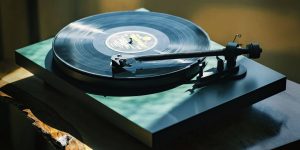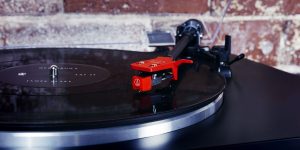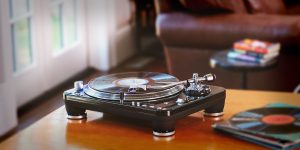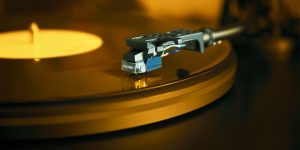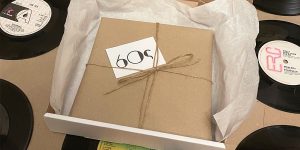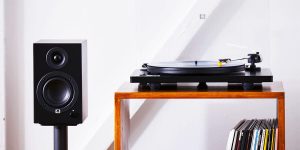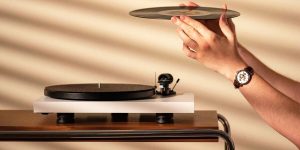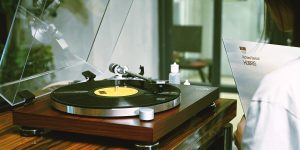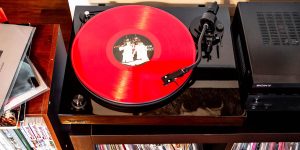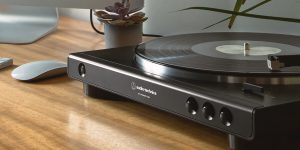If you’re in the market for the best belt-drive turntable, I’m here to assist you. However, let’s first clarify what we mean by “belt drive”. At its core, such a player employs a motor that’s offset from the platter, connected by a slender belt that spins your records with precision and care. This design is particularly cherished by those who seek the warmth and authenticity of vinyl sound, as it minimizes motor noise interference, offering a purer audio experience.
In this article, I’ll provide a detailed review of turntables across a range of prices. This will help you find a model that meets both your needs and budget.
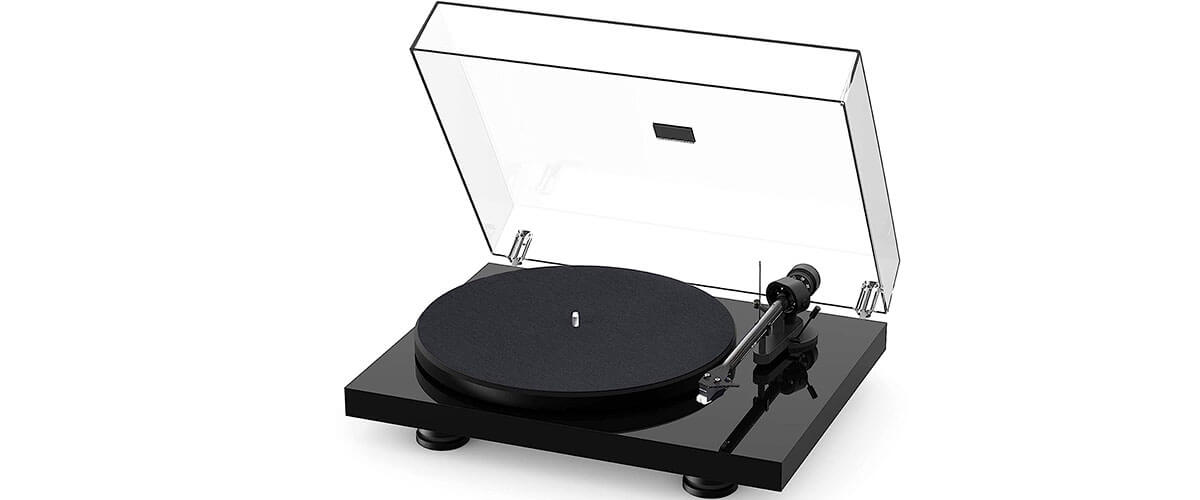
Belt drive turntables comparison table
| Name | Drive type | Operation type | Speeds | Phono Pre-Amp | Bluetooth | Review |
|---|---|---|---|---|---|---|
| Pro-Ject Debut Carbon EVO best overall | belt | manual | 33 1/3, 45, 78 RPM | no | no | Review |
| Fluance RT85 also great | belt | manual | 33 1/3, 45 RPM | yes | yes | Review |
| Audio-Technica AT-LPW40WN budget | belt | manual | 33 1/3, 45 RPM | yes | no | Review |
| Fluance RT81 for beginners | belt | manual | 33 1/3, 45 RPM | yes | no | Review |
| Audio-Technica AT-LP7 under $1000 | belt | manual | 33 1/3, 45 RPM | yes | no | Review |
Best belt-drive turntable reviews
Pro-Ject Debut Carbon EVO – best overall

Pro-Ject is one of my favorite brands, renowned for its high-quality designs, vivid colors, and superior sound quality, all at a reasonable price. They launched the Debut line in 1990, and since then, these turntables have been a hit among vinyl enthusiasts. So, our Debut Carbon EVO is a rare gem (forgive me for this pomposity) that marries a rich history, high-quality components, and a moderate price tag.
My favorite features? This model boasts a sleek and slim body with no frills – it leans towards a higher-end segment due to its fully manual operation and lack of extras. All audiophiles agree – the fewer components a TT includes, the better. Although it’s not the heaviest model out there, its steel platter with TPE damping does the job well, reducing vibrations and resonance.
In all honesty, I’m not a fan of straight tonearms (they are associated with cheaper decks), but I must admit EVO’s straight 8.6-inch carbon fiber arm is not bad at all – it’s light but strong, contributing to accurate tracking and reducing vinyl wear.
The Sumiko Rainier is a subject of dispute among many audiophiles. But, in general, it’s good and easily handled different types of music during my testing. And let’s remember that the EVO is a decent yet mid-range model, so we can’t expect a high-end cart here.
Another thing I really appreciated: if you’re the kind of person who moves around a lot, the Pro-Ject has got you covered with power plugs for different countries. Small detail, but a lifesaver for some.
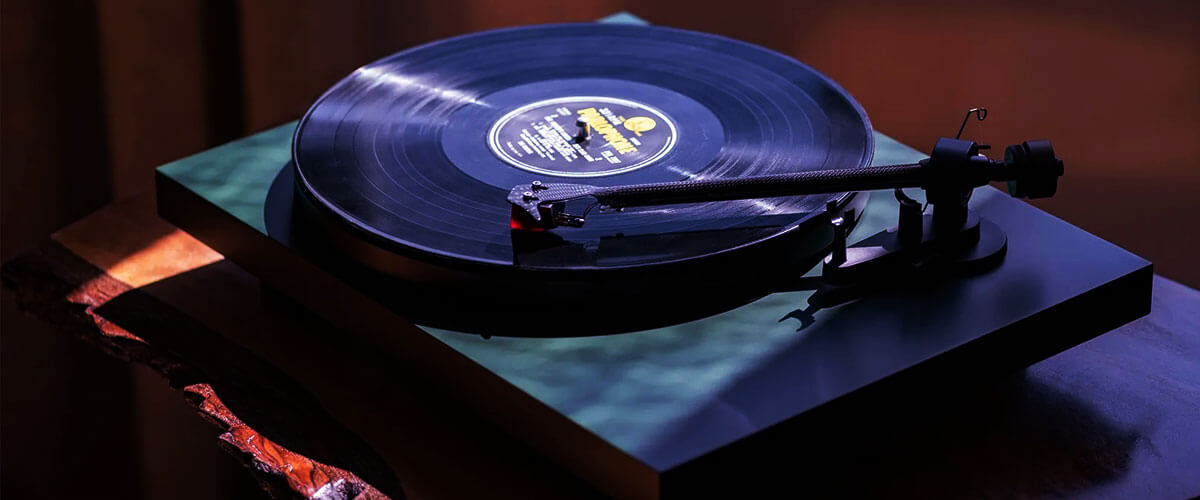
Now, about the quirks. The speed selection switch is hidden under the plinth, making it difficult to access. I mean, who thought that was a good idea? On the other hand, you may not use it too often.
Next, setting this unit up can be a bit of a headache, especially if you’re new to vinyl. Getting the tonearm’s force just right feels like you need a degree in turntable engineering. It’s a bit of a hassle, and I can see some folks getting frustrated.
And the cover design… well, it could use some work. There are no rubber protectors – it’s quite strange, considering the TT’s glossy surface – I think scratches may develop over time. And, yes, the hinges aren’t sturdy enough.
To conclude, Pro-Ject Debut Carbon EVO is definitely the best belt-driven turntable since it boasts a great combination of traditional design, high-quality components, good sound, and adequate price. It’s the right solution if you want a decent, classic model but don’t want to ruin your family budget.
Key specs
- Drive type: belt.
- Operation type: manual.
- Speeds, RPM: 33 1/3, 45, 78.
- Phono Pre-Amp: no.
- Bluetooth: no.
- USB: no.
- Aux input: no.
Pros
- One-piece carbon fiber tonearm.
- Sumiko Rainier cartridge – good quality sound with upgrade potential.
- Heavy platter with TPE damping – effectively reduces vibration.
- Quality cables provided.
- International power plugs.
Cons
- Setup complexity – setting up the tonearm’s vertical tracking force can be challenging and time-consuming.
- Inconvenient speed switch.
- Lid design issues.
Fluance RT85 – also great
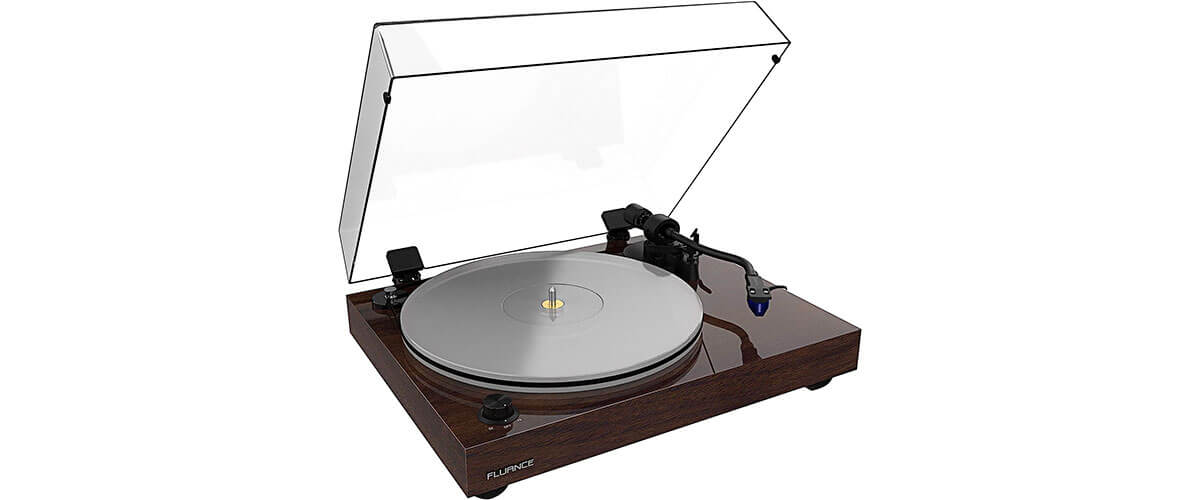
Fluance is another brand that manages to balance good sound with sleek designs without burning a hole in your wallet. I do like their mid-range belt-drive record player – RT85, and here’s why.
First things first, the Ortofon 2M Blue elliptical cartridge is the finest option among middle-priced carts. Its sound quality is notably bright and flat, avoiding any exaggerated bass or odd sound curves. When I spun everything from Beethoven to The Beatles on this turntable, the cartridge’s versatility really shone through. It handled each genre with ease, delivering a clean and balanced sound.
Another thing I appreciate is the high-density acrylic platter. Customers are right to rave about it – no slipmat is needed, and it provides a stable, resonant-free platform for your records. Spinning some vinyl on it, the stability and clarity were indeed noteworthy.
Now, I’ll explain why the RT85 is somewhat inferior to the Pro-Ject Debut Carbon EVO. The former has a J-shaped tonearm – yes, it’s believed to track the grooves better; however, it’s so fragile that I feared I might rip it during testing.
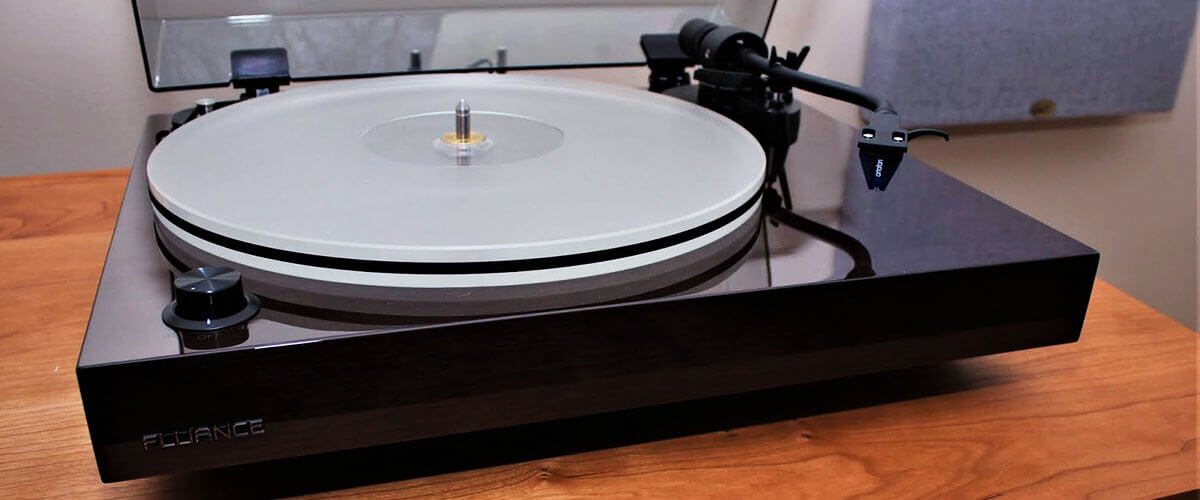
Next, the semi-auto mode seems to be a bit of a double-edged sword. On the one hand, it’s great that it automatically stops the record from spinning when not in use – a handy feature for protecting your vinyl. But when you’re done and move the tonearm back, the platter briefly starts up again. Also, the turntable won’t start spinning until you’ve placed the tonearm over the record. This requires a bit more attention from you to avoid any accidental damage to your stylus or LP.
The cue lever on the RT85, though functional, doesn’t quite match up to the rest of the turntable’s build quality. It feels a bit flimsy and awkwardly positioned. This was echoed by some users, and in my use, I also found it a tad inconvenient.
In summary, the Fluance RT85 is a turntable with much to admire, especially its audio performance with the Ortofon 2M Blue elliptical cartridge and acrylic platter design. However, its semi-auto mode and some aspects of the tonearm design require a careful, informed approach. It’s a turntable that offers high-quality audio output but with features that demand a bit of a learning curve and attention to detail.
Key specs
- Drive type: belt.
- Operation type: manual.
- Speeds, RPM: 33 1/3, 45.
- Phono Pre-Amp: yes.
- Bluetooth: yes.
- USB: no.
- Aux input: no.
Pros
- Decent sound thanks to the Ortofon 2M Blue cartridge.
- Acrylic platter – no need for a mat, aesthetically pleasing and good sound quality.
- High mass MDF plinth – excellent vibration dampening.
- Adjustable resonance damping feet – adds to stability and sound quality.
Cons
- Complex semi-auto mode – adds operational complexity and potential for damage if not used correctly.
- Cue lever feels cheap and poorly positioned.
Audio-Technica AT-LPW40WN – budget
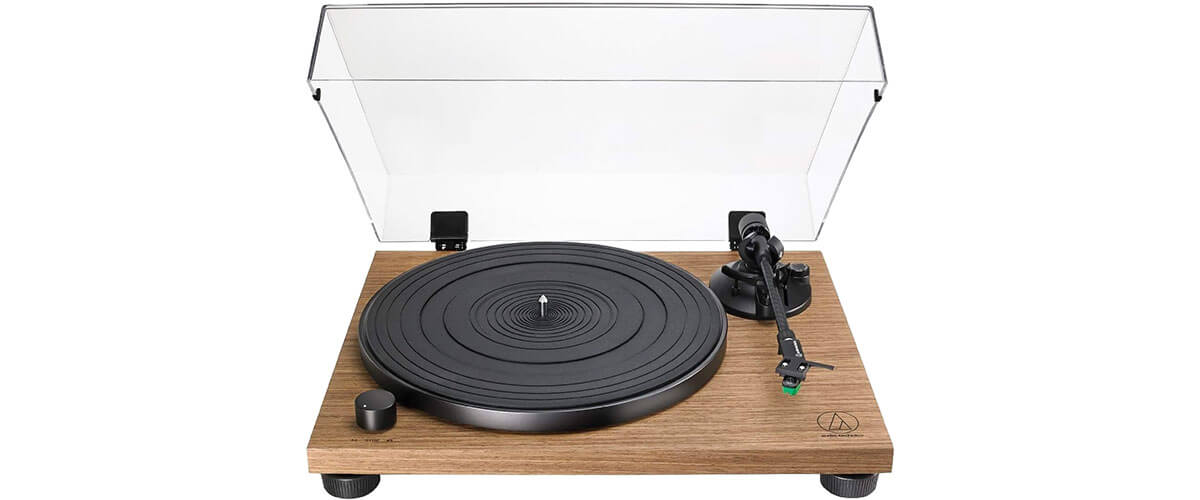
I’m passionate about vinyl, that’s why I always approach budget turntables with skepticism. The Audio-Technica AT-LPW40WN caught my attention with its promise of high-quality features at an affordable price, so I was keen to put it through its paces.
The AT-LPW40WN exudes a certain charm – its design is sleek and modern. Setting it up was straightforward, but I did notice the leveling feet needed a bit more finesse to get just right. I recommend having a small bubble level handy, as getting this turntable perfectly horizontal is important for optimal performance.
The fully manual operation is a nod to traditionalists, and I appreciate the control it offers. The die-cast aluminum platter, coupled with the rubber mat, lays a solid foundation for stable playback. When I dropped the needle on some of my favorite records, the AT-VM95E cartridge did not disappoint. The sound was clear, detailed, and had a warmth to it that I often miss in budget turntables.
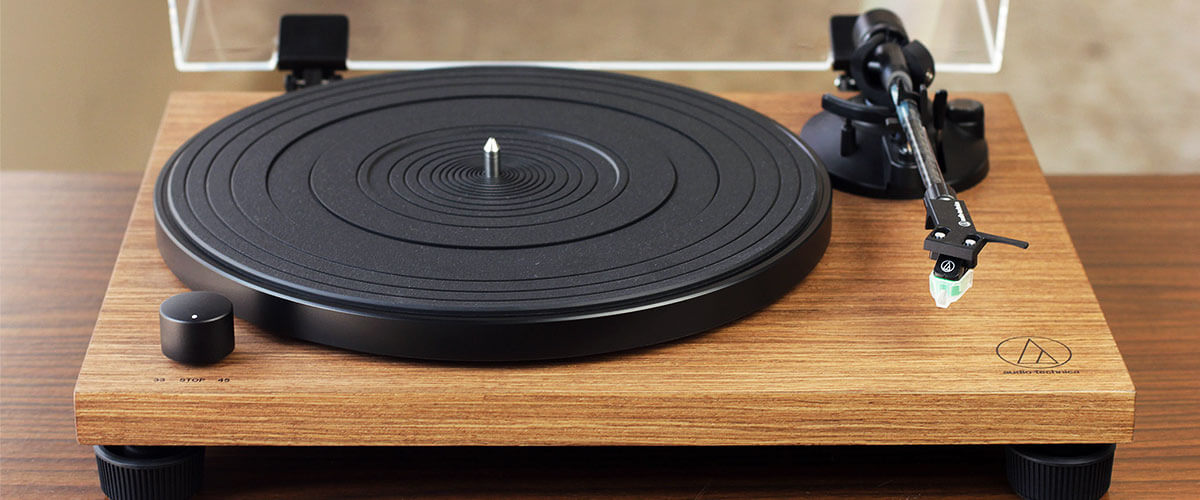
But what truly surprised me was the carbon fiber tonearm, a feature usually reserved for more expensive models. It added a level of sophistication to the sound quality that’s hard to ignore. Furthermore, the adjustable dynamic anti-skate control is a boon for those who are meticulous about their setup.
However, let’s not forget the table’s budget nature. I encountered an issue with motor noise at higher volumes. Next, the durability came into question when the speed knob’s glue gave way after a few uses. The power switch placement at the back was a bit of a puzzle. It’s not the most convenient location and takes some getting used to.
The Audio-Technica AT-LPW40WN is the best budget belt-drive turntable – it offers features and sound quality that punches above its weight class. For those on a budget, it’s a worthy contender that delivers where it counts, but with a few caveats to keep in mind.
Key specs
- Drive type: belt.
- Operation type: manual.
- Speeds, RPM: 33 1/3, 45.
- Phono Pre-Amp: yes.
- Bluetooth: no.
- USB: no.
- Aux input: no.
Pros
- Good sound for the price.
- Fully manual operation – offers complete control to the user, typically preferred by enthusiasts.
- Speed-sensor system – ensures accurate platter speed.
- Adjustable dynamic anti-skate control – helps in maintaining the balance of the tonearm.
- Die-cast aluminum platter with rubber mat – contributes to stability and vibration reduction.
Cons
- Motor noise/hum at higher volumes.
- Glue issues with speed knob.
- Inconvenient placement of power switch.
Fluance RT81 – for beginners
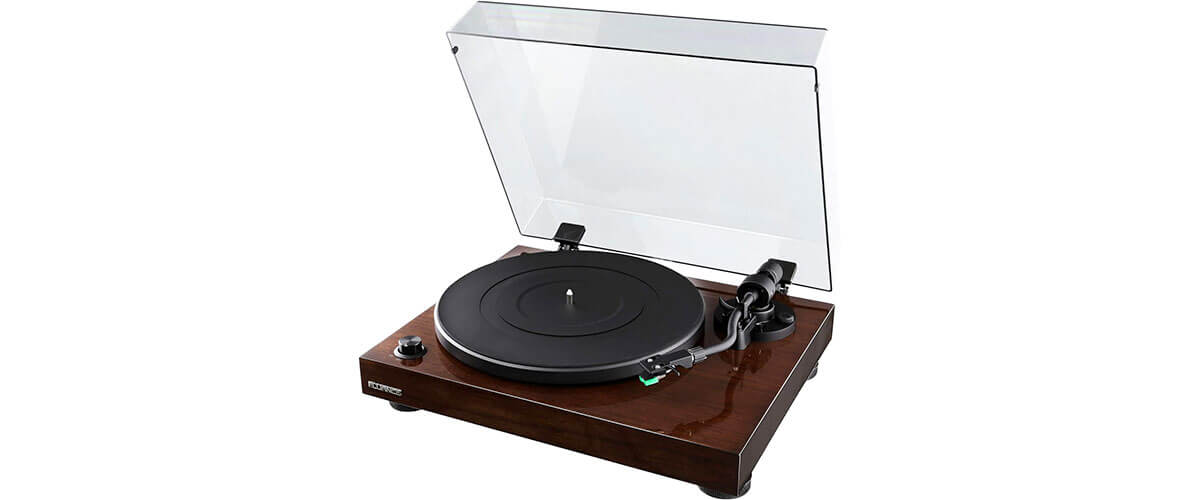
The Fluance RT81 has been creating some buzz in the budget-friendly market, so I was curious to see how this model stacks up.
The first thing you’ll notice is that the RT81 and RT85 appear remarkably similar, almost like twins. Both boast a solid construction complemented by an elegant wood plinth. However, the former is slightly lighter, making it more susceptible to vibrations. And the rest of RT81’s features show its cheaper nature.
This model is equipped with the Audio Technica AT95E cartridge – a commonly used option for entry-level players. This cart is not bad, but surely falls short when compared to Ortofon 2M Blue found in the RT85. However, I appreciated the balanced aluminum S-type tonearm, which contributes to a generally clear and accurate sound reproduction.
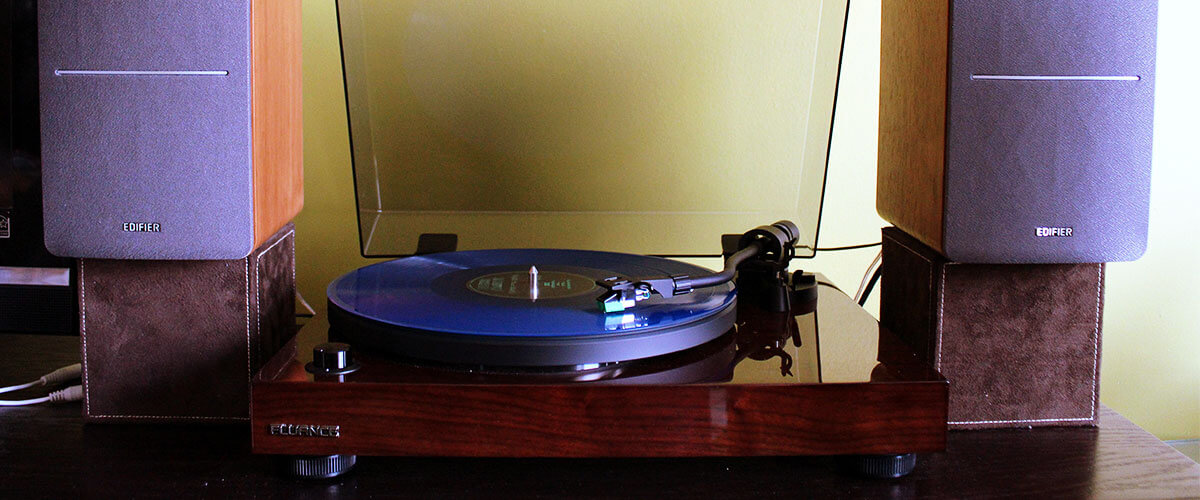
As the RT81 is intended for beginners, it has a built-in preamp, and its quality is commendable for a budget turntable. Plus, the preamp can be bypassed when you are ready for a more advanced setup.
I was a bit disappointed with the speed accuracy, but, on the other hand, it’s only noticeable for trained ears. Another thing I don’t like is that the RPM adjustment is inconveniently located at the bottom – for me, it was a bit of a hassle to access.
Overall, the Fluance RT81 is a solid choice for beginners – it offers good value for its price. Of course, this player won’t outperform high-end models, but for its cost, it provides a satisfying entry into the world of vinyl.
Key specs
- Drive type: belt.
- Operation type: manual.
- Speeds, RPM: 33 1/3, 45.
- Phono Pre-Amp: yes.
- Bluetooth: no.
- USB: no.
- Aux input: no.
Pros
- Beginner-friendly design – easy to assemble and operate.
- Balanced aluminum S-type tonearm.
- High-mass MDF wood plinth – offers a stable and aesthetically pleasing base.
- Built-in preamp and quality outputs.
Cons
- Rotation speed inaccuracy – may impact sound quality, especially noticeable to discerning listeners.
- RPM adjustment location.
Audio-Technica AT-LP7 – under $1000
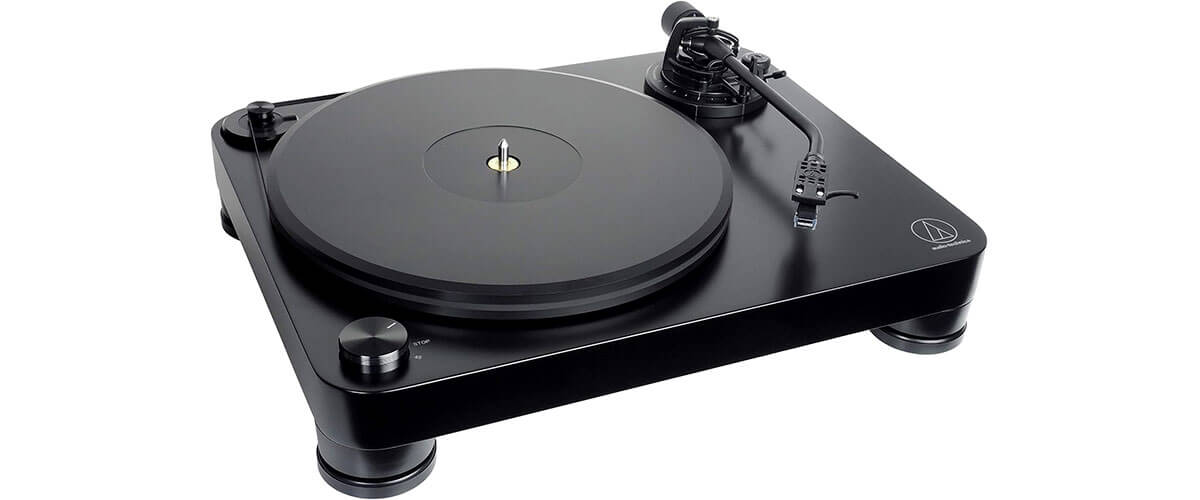
It’s always difficult to find something that balances the scales between top quality and affordability, classic design and modern convenience. But Audio-Technica managed to do it with the AT-LP7. It is not exactly the premium model, but it’s very close to it.
This turntable has a presence that’s hard to miss. It’s the most weighty and solid model on my list. Handling it, I felt the quality in its construction – the 40mm-thick MDF chassis gives it a substantial, grounded feel.
The J-shaped tonearm is a beauty, both in looks and function. It glides smoothly, and the precision bearings seem to do their job well, keeping the tracking accurate and stable.
The VM520EB Dual Moving Magnet cartridge is not your run-of-the-mill option – Audio-Technica took care here. Spinning some of my favorite albums, the sound was detailed. However, I can see why some audiophiles might find it a bit on the “thin” side. The cart is great, but if you’re all about that deep, rich sound, you might want to upgrade it.
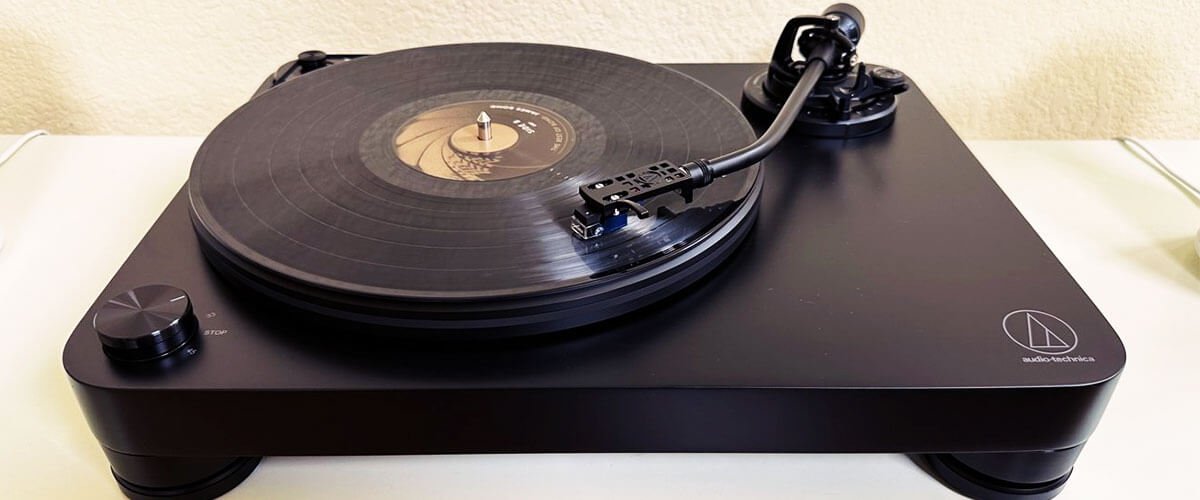
Generally, I like simple designs without built-in extras; however, AT-LP7’s integrated phono preamp pleasantly surprised me. It’s actually quite good for an onboard system, handling both MM and MC cartridges. Sure, it doesn’t quite match up to a standalone phono stage in terms of depth and holographic soundstage, but it holds its own. The bass is decent, and the highs are there, just not as extended as some might like. The option to switch it off is a nice touch, giving you flexibility if you have a preferred external preamp.
Now, the power cord setup is a bit unusual. It’s an old-school AC adapter, which I suspect is there to keep electrical hum at bay. In my setup, this seemed to work – I didn’t pick up any interference through my speakers.
Wrapping up, the Audio-Technica AT-LP7 is definitely a reliable workhorse. It’s durable, heavy, and has a ton of engineering that you can’t see, but I’m sure you can hear. This is one of the belt-drive turntables that will satisfy most vinyl fans looking for top quality without venturing into the deep waters of high-end gear.
Key specs
- Drive type: belt.
- Operation type: manual.
- Speeds, RPM: 33 1/3, 45.
- Phono Pre-Amp: yes.
- Bluetooth: no.
- USB: no.
- Aux input: no.
Pros
- Quality cartridge with excellent channel separation.
- J-shaped tonearm with precision bearings – enhances tracking accuracy.
- Built-in switchable pre-amplifier – versatile for different cartridge types.
- Solid MDF chassis – reduces resonance.
- Anti-resonance platter – for stable rotation.
Cons
- AC adapter power cord – unusual choice, may be inconvenient.
What to look for when choosing a vinyl player
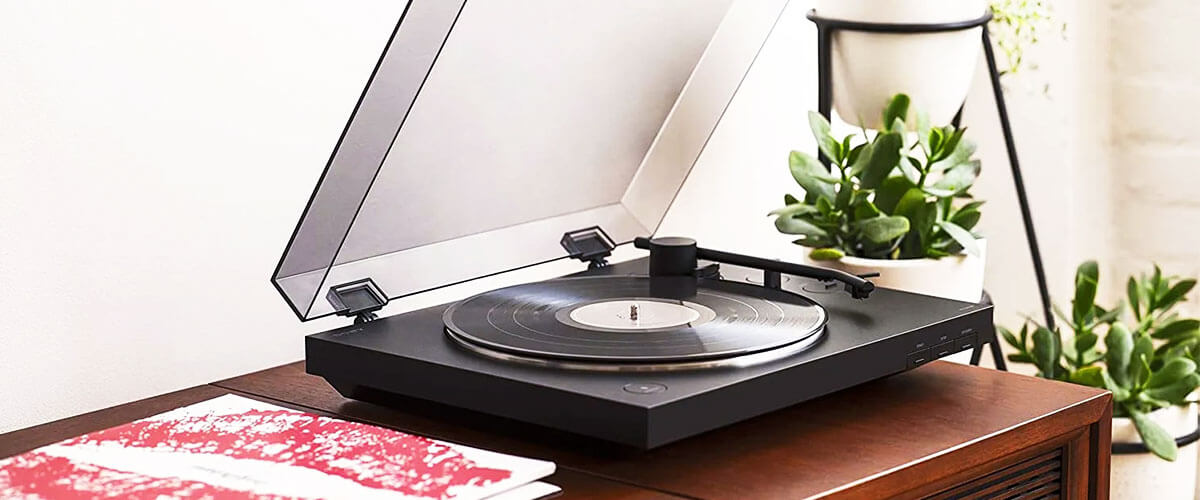
Platter design and material
As a quite picky listener, I’ve come to appreciate the significance of a well-crafted vinyl platter. A platter is the heart of any turntable, it’s important for reducing vibrations and maintaining a steadfast rotational speed – key factors that affect sound clarity and fidelity.
There are various platter materials, even leather. However, the most popular are aluminum, steel, acrylic, and glass, each with its own set of pros and cons.
Aluminum platters, mostly seen in budget-friendly TTs, are lightweight. It’s not the worst option out there, but audiophiles state (and I do agree with them) that such plates lack the damping properties of heavier materials. It means you shouldn’t expect vibration-free audio.
Steel, on the other hand, is heftier, providing better stability and vibration reduction. The downside? Its weight can put more strain on the motor, possibly affecting its longevity.
Acrylic platters are a favorite in my collection. They inherently dampen vibrations, offering a purer sound. Plus, they eliminate the need for a slipmat. However, acrylic can be prone to static electricity, which might attract dust to your records.
Glass, with its sleek appearance, offers superb rotational stability due to its weight. This results in a consistent speed and reduced vibration. But, glass can be fragile and might ring or resonate if not properly designed or coupled with the right base.
As you can see, each material has a unique impact on the sound. So, just remember that choosing a platter is not just a matter of aesthetics.
Motor and belt quality
The choice of motor type is very subjective. I’ve always leaned towards turntables with DC motors. Why? They’re the strong, silent type. DC motors maintain a steady speed without making a fuss – exactly what you want for uninterrupted, pitch-perfect playback.
Now, let’s talk belts. You might not give it much thought, but this little loop is a hero in its own right. I’ve had the finest experience with synthetic rubber belts – think neoprene or silicone – they’re resilient, consistent, and don’t tire easily. This means fewer replacements, and more importantly, they keep those pesky motor vibrations from crashing your vinyl party.
Tonearm and cartridge specifications
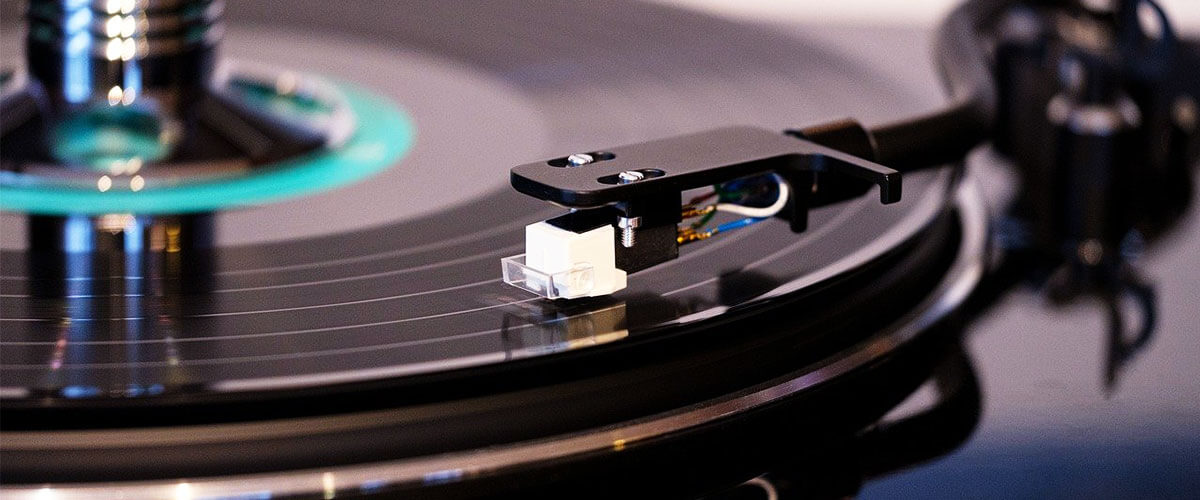
A tonearm and cartridge are like the lead performers in an orchestra – they can make or break the sound quality.
There are three main types of tonearms: straight, J-shaped, and S-shaped. Think of straight tonearms as the minimalists of the bunch. They’re straightforward, with no frills or curves, which helps in keeping tracking errors at bay. But there’s a twist: the shorter these arms are, the nimbler and lighter they feel. Longer ones, though, have to wrestle with inward pull, which adds a bit of complexity to their design.
J-shaped tonearms are the smooth operators. Their longer effective length means they track your records like a dream, decreasing errors and improving sound. Plus, they have this neat trick of balancing the counterweight just right, which helps cut down vibrations.
And then there’s the S-shaped tonearm, the elegant classic. Not only do they look great, but they’re also gentle on your records. Their shape is all about reducing distortion and keeping the stylus right on track, literally.
As for cartridges, the two main types are moving magnet (MM) and moving coil (MC). Moving magnet cartridges are the more common and budget-friendly option. They’re known for their versatility and ease of use, offering a replaceable stylus – a boon for long-term maintenance. The sound quality is generally good, with a bright and vibrant character.
However, audiophiles often choose moving coil cartridges. They’re typically more expensive but offer a level of sonic detail and depth that MM cartridges struggle to match. With an MC cart, you’re likely to experience a more refined, nuanced sound. The catch? They often require a more specialized phono preamp and are more delicate to handle.
Vibration isolation and damping mechanisms
Vibration isolation focuses on shielding your music from those unwelcome shakes and rumbles that can intrude on the listening experience. Imagine you’re listening to a serene classical piece, and suddenly, there’s a buzz from the turntable. Not ideal, huh? That’s where isolation comes in. Good players often have feet designed to absorb these vibrations. Some use springs, others go for rubber or even sorbothane – a material that’s like a superhero in the world of vibration absorption.
Damping, on the other hand, handles internal vibrations. This is where the TT’s construction plays a big role. Heavier plinths (the turntable base) naturally absorb more vibration. Additionally, the choice of platter mat – be it rubber, felt, cork, or leather – isn’t just an aesthetic decision. These mats serve as a buffer between the platter and the record, minimizing the transfer of unwanted resonance to the needle.
So, do pay attention to these details – they are really important for a clear, unadulterated audio experience.
Connectivity and additional features
Many modern turntables are decked out with all sorts of handy features. Think built-in preamps that save you the hassle of extra gear, USB ports for turning your vinyl classics into digital files, and Bluetooth for those who want to groove without cables cramping their style. These turntables are versatile and ready for just about anything.
But when you step into the audiophile territory, it’s a whole different vibe. Here, it’s all about stripping things back to the essentials. High-end machines keep it super simple – no USB, no Bluetooth, just pure, unadulterated sound.
Sure, I understand the charm of up-to-date players, but as a true connoisseur, I couldn’t help but mention what real beauty looks like.
We are supported by our audience. When you purchase through links on our site, we may earn an affiliate commission at no extra cost to you.
Our newsletter
* We will never send you spam or share your email with third parties

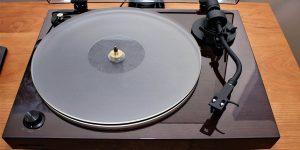

![Best Turntables Under $100 [Reviewed and Tested]](https://righttechadvice.com/wp-content/uploads/2023/09/best-turntable-under-100-300x150.jpg)
![Best Turntables Under $300 [Reviewed and Tested]](https://righttechadvice.com/wp-content/uploads/2023/10/best-turntable-under-300-review-300x150.jpg)
![Best Record Players Under $200 [Reviewed and Tested]](https://righttechadvice.com/wp-content/uploads/2023/10/best-turntable-under-200-300x150.jpg)
